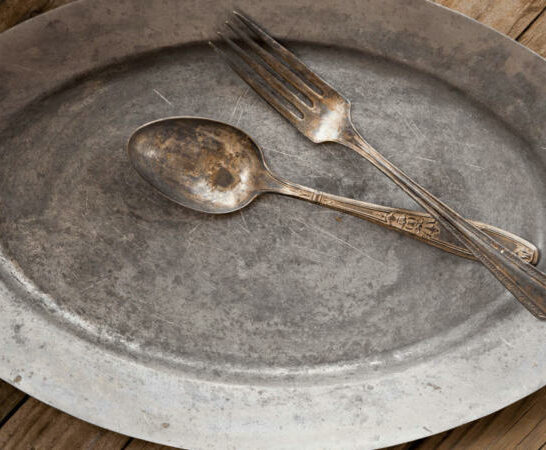I think we have all been in a situation where we sit down for a nice meal, cut into it, and as that fork nears your mouth, you see that tarnish.
And then the questions pop up. Is it clean? Is it safe? Should I eat with this? Here are some answers regarding tarnished silverware.
Is it safe to eat with tarnished silverware?
Silver is not toxic, and it is safe to eat with silverware. Even tarnished silverware is safe to eat with as long as it is clean. While tarnish may not look appealing, it will not harm you. This is also true of silverware with silver plating. However, you will want to ensure that it is actually silver and that what you are seeing is tarnished and not something more toxic.
Silver Is Not Toxic
Often, silverware can become a family heirloom that is passed on for generations. So, some people may be using some of the same silverware for decades at a time.
One of the reasons silver is used in flatware is because the metal is not toxic to humans.
That is why people can use the same sets of cutlery for generations. If your silverware is silver, you don’t have much to worry about.
If metal tarnishes, you can polish it up and use it again.
Even when using tarnished silverware, it may not look pretty, but it will not harm you as long as it is still clean. Polishing your silver just helps give everyone peace of mind.
Silver is not a toxic metal, but silverware is never 100% silver.
Other metals are used to provide some support and sturdiness to your silverware.
It is of paramount importance that you know what your silverware is made of, or at least that certain metals are not present.
Potential Danger
Heirloom silverware or older silverware passed through multiple hands or passed down through the generations can potentially have other hazardous materials in their makeup.
The most dangerous of these materials is lead.
If you have a new set of silverware, you will want to ensure that there is not any lead in the silverware.
Lead poisoning is not something that you want to get.
Fortunately, there exist some simple tests that can be purchased so you can find out if your silver has lead in it.
These are generally fast-acting, and after around 20 minutes, you will know about your silver.
Other metals commonly used in silverware to add some strength and durability are pewter and copper. These materials are not toxic to us either.
However, they can also attract lead, so be sure to test for lead.
Silver and Tarnish
Silver is a brilliant metal that has a beautiful shine.
However, the metal is prone to tarnish, which can be a monumental task for upkeeping your jewelry or silverware.
Silver tarnishes because of the metal’s exposure to gases in the air that contains sulfur.
These gases react with the silver, which causes that outer layer of tarnish on your silverware.
While the tarnish is not necessarily toxic, it can be a real pain to clean up.
This is especially true if the silver has been left out or neglected for long periods of time.
There are many methods that people will tell you to try out to help rid your silverware of tarnish, but few are as good as buying a small tub of silver polish at the store and treating your silverware with it.
There is one method I will mention that consists of boiling water in an aluminum-lined bowl with some household chemicals.
This method is ideal because it allows you to clean many pieces of silver at once without applying polish to each piece separately.
By putting your pieces of silver submerged in the aluminum-lined bowl, you will be able to clean the tarnish off of many pieces effectively and quickly.
Foods to Avoid with Silverware
Pure silver does have some chemical reactions with certain foods and chemicals. So, it is necessary to potentially avoid certain foods if you know that you will be using the family silverware.
As mentioned before, silver and sulfur do not get along. So, foods high in sulfur are not a great option to eat with silver. A number of things could happen.
First, the sulfur in the foods can cause the silver to discolor. Sulfur-based foods can be hard on silver plates and utensils.
Also, in extreme cases, your silver will be discolored, but the reaction can be strong enough to affect the taste of the food.
The last thing that you want is for your silverware and food to work together to ruin the flavor.
Some foods that are high in sulfur include many dairy products like certain cheeses, eggs, and milk.
Eggs are especially dangerous for silver due to the nitrogen inside of the eggs. When silver and nitrogen combine, they can form silver nitrate, which is poisonous to humans.
Foods containing large amounts of soy will generally have a high nitrogen content.
Other foods to potentially avoid with your silverware are peanut butter, mustard, and horseradish.
Frequently Asked Questions About Is it Safe to Eat With Tarnished Silverware
Is lead a common alloy in silverware?
It is not common anymore, especially today. We have learned a lot about lead poisoning over the years. However, certain types of silverware combinations can attract lead as well. In these cases, it is always better to be safe and check.
Conclusion
If you inherited a nice set of silverware from your grandparents or found some beautiful silver at an antique shop, do not be discouraged by the tarnish.
Tarnish is not toxic, and it can be cleaned up with a little bit of elbow grease.
However, if you do not know the history of the set of silver, it is always better to check for potentially harmful substances like lead before you use it.

